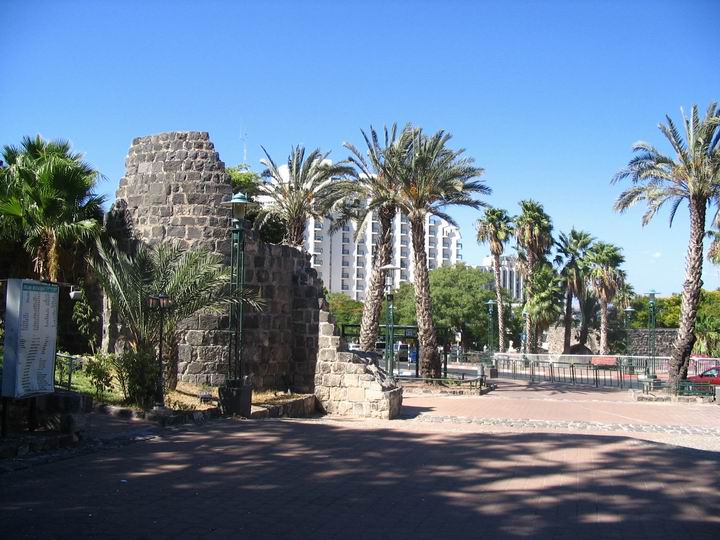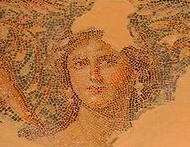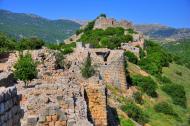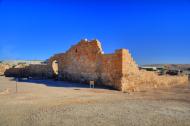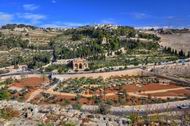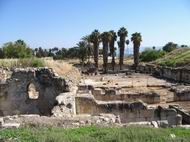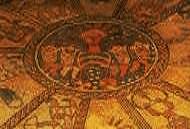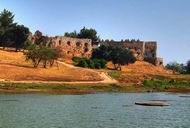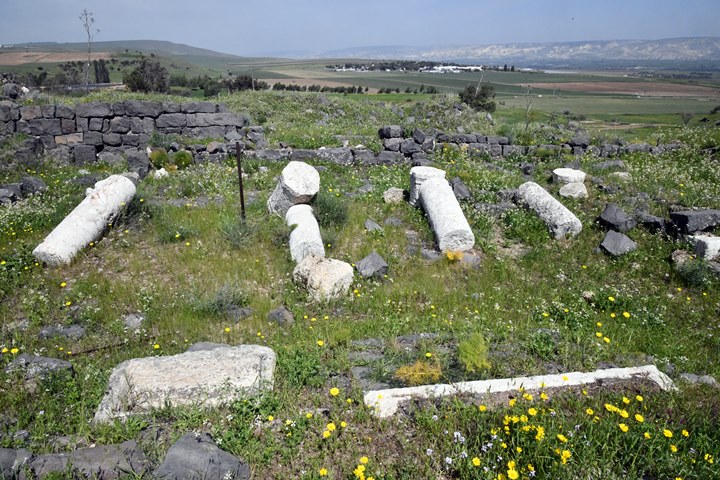This overview page reviews the subject of earthquakes, maps to a sample of sites that were affected by the quakes, and provides Biblical references.
Matthew 28 2: “And, behold, there was a great earthquake…”.
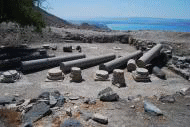
Home > Info > Structures > Earthquakes
Contents:
Introduction
History
Examples
Sites
Biblical
References
Introduction:
The region surrounding the Dead Sea and the Jordan River Valley, which includes Israel and its neighboring countries, has a history of significant earthquakes due to its location on the Dead Sea Transform Fault. This fault line is a major plate boundary that separates the African Plate from the Arabian Plate and is a source of significant seismic activity in the region.

Devastating quakes have been documented during thousands of years, causing damages to structures and people. Many structures have been repaired, rebuilt or abandoned over the years, as attested in most of the historical sites.
This web page provides a summary of the greatest quakes, a sample list of sites where the earthquakes caused damages, Biblical references, and links to additional information.
We thank Prof. Amotz Agnon for the assistance in preparing this web page.
History:
A timeline of the major earthquakes in the Holy Land is listed below:
Late Bronze (LB): 1550 BC – 1200 BC
- 1365 BC – Earthquake
Early Israelite:1200 BC -1000 BC
- 1050 BC: Earthquake on Jordan rift valley; destroyed major Iron Age I cities such as Dan and Megiddo
Middle/Late Israelite: 1000 BC 586 BC
- 759 BC – Earthquake in Lebanon
Babylonian/Persian: 586 BC – 332 BC
- 525 BC – Earthquake and Tsunami, west of Lebanon
Hellenistic: 332 BC – 37 BC
- 138 BC – Earthquake, Tsunami floods Acre
Early Roman: 37 BC 70 AD
- 31 BC: Major earthquake in Jordan valley (7 magnitude), 10,000 dead
- 33 AD: Earthquake in Jerusalem
Late Roman: 70 AD – 324 AD Byzantine 324 AD – 634 AD
- 363: Severe earthquake in Galilee, Golan
- 419: Earthquake in Mt Carmel area
- 498: earthquake in Sharon/Judea region
- 551: Severe earthquake west of Jordan valley; damages in Galilee, Golan
Arab: 634 AD – 1099 AD
- 658: Major earthquake
- 749: severe earthquake in Jordan valley (>7 magnitude; also years 747 and 757)
- 853/4: earthquake in Tiberias
- 1033: severe earthquake in Jerusalem and Samaria
- 1068: Earthquake in southern Negev
Crusaders: 1099 AD – 1250 AD
- 1160: Earthquake in Judea
- 1202: Earthquake near Sea of Galilee (7.6 Magnitude)
Mameluke: 1250 AD – 1517 AD
- 1293: Earthquake south of Dead Sea
- 1458: Earthquake south of Dead Sea
Ottoman: 1517 AD – 1920 AD
- 1546: Earthquake in Sharon area
- 1759: Earthquake in the Golan; 2 strong quakes; Landslides in Zefat
- 1822: Earthquake
- 1837: Earthquake in Galilee area; Zefat and Tiberias are destroyed (~6.5+ magnitude)
- 1856: Major earthquake (Center in Crete, affecting the Levant)
British Mandate: 1920 AD – 1948 AD
- 1927: Earthquake in Dead sea area (6.3 magnitude); serious damages to Jericho, Nablus, Jerusalem, Ramla
State of Israel: 1948 AD – present
Examples:
An example of the effects of an earthquake is captured in this photo, following the quake of 1927 with an epicenter in the Dead Sea. The house in Nablus [Shechem] was reduced to a mere shell.
Photos of the Library of Congress – American Colony, 1927
Another example is the effect of the January 1, 1837 earthquake that severely damaged Tiberias. It toppled sections of the city walls and most of the buildings. More than 700 persons were killed and the city was in total ruins. This round turret was damaged in that event.
Sites with earthquake effects
A sample of Biblical/Historical sites, featured in BibleWalks.com, is listed below. For more details on each site – click the header.
The large city was leveled by a massive earthquake in 749 AD. The earthquake leveled the structures and colonnaded streets, It was in ruins until recent archaeological excavations which are unearthing and reconstructing this amazing city.

The great Roman and Byzantine city of Lower Galilee; capital city and major Jewish center during the Byzantine period. The city was heavily damaged by nature – a major earthquake (363 AD) hit most of the cities in the Galilee and Israel. It was rebuilt and continued to flourish until the decline in the Arab period (7th century).
Hippos (Sussita)
Hippos (Sussita) is an ancient city located on the plateau of a diamond shaped mountain by the eastern shores of the Sea of Galilee. A major earthquake devastated the city on Jan 18 749 AD: it toppled most of the buildings, knocking down its massive pillars, killing tens of thousands in the region. The few citizens who survived the quake relocated to other sites in the Golan. The city laid in ruins since then, totally covered by the debris.

The Nimrod fortress (Qal’at Namrud, Qal’at Subeiba) is one of the largest and most impressive fortresses in Israel. The fortress guarded the main road from Tyre and Tiberias to Damascus during the Crusaders period.
An earthquake in 1759AD shocked the fortress and caused damages.
A 5th C AD monastery in Mishor Adummim, on the road from Jerusalem to Jericho and the Jordan valley. It was founded by the hermit Euthymius “the Great” in 428AD as a Laura (or Lavra – a monastery of hermits, with small cells).
The monastery was severely damaged in the 659AD earthquake, and most of it was rebuilt within several years.
The prophet Zechariah describes that an earthquake will split Mount of Olives to 2 parts, south and north, and describes the horrors of that day which will be recognized as God’s acts, but will be followed by a salvation.
(Zechariah 14): “…and half of the mountain shall remove toward the north, and half of it toward the south. And ye shall flee … like as ye fled from before the earthquake in the days of Uzziah king of Judah: and the LORD my God shall come, and all the saints with thee”.
A 12th century Greek-Orthodox monastery, on the side of the road from Jerusalem to Bethlehem. Built over the ruins of a Byzantine church, it serviced the pilgrimage route to Bethlehem.
The monastery was severely damaged by an earthquake (1160 AD), after a previous quake (1033/4) already shattered the structure. Immediately after the quake, the monastery was built again during the Crusaders period.
Ruins of a grand winter palace for the Arabic rulers from Damascus. Built in the 8th century AD near Tell Kinneret. The palace was destroyed in a severe earthquake (749 AD).
Located on the western shore of the sea of Galilee, this city is one of the Holiest Jewish cities for almost 2000 years. In 749 AD the great earthquake destroyed most of the structures in the area. In 1837 a great earthquake devastated the city.
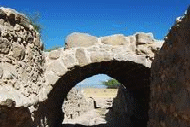
Ruins of a famous Roman period settlement on the north-western shore of the Dead Sea. This was the home of the Essenes, a break-away sect.
After the earthquake of 31 BC in the Jordan valley, during the times of King Herod the Great, the settlement was severely damaged and deserted. The Essenes returned to rebuild the site in 4 BC.

An ancient synagogue from the Byzantine period, where a beautiful mosaic floor was found, illustrating a Zodiac, the Ark, and the binding of Isaac.
The synagogue continued to function under Arab control, but was destroyed in the massive earthquake of 749AD which leveled many of the towns and cities in the region. It remained in ruins until the 20th century.
Afek (in Sharon)
Tell Aphek (Afek, Antipatris) was a gateway on the main trade route from north to south. More than 6,000 years of successive cities have been built on the mound overlooking the springs of the Yarkon river.
The city was damaged by a massive earthquake in 363 AD, when most of the cities in the Galilee and Israel sustained severe damages. The city did not recover – during the Byzantine period it was a small military station.
On the north and south walls of the ruined fortress are cracks, 2.1m wide, evidence of the earthquakes that shocked the area since the construction of the fortress.
According to the study by R. Ellenblum et. al, the displacement was caused by the great earthquake of May 20, 1202 (causing a 1.6m offset), then again in the earthquakes of 1759 and/or 1837 (additional 0.5m offset).
The fault line crosses the length of the fortress. A white roof was constructed above the point where the fault passes the north wall, in order to record the movements of the earthquake fault line.
Tel Iztabba
This city, an extension of Beit Shean during the Byzantine period, was leveled by a massive earthquake in 749 AD, as it did in the neighboring city. The earthquake leveled the structures and the columns in this church, as seen in this view. (view in BibleWalks YouTube)
The structure was the central bath in the Roman city. In 498 AD the structure was damaged by an earthquake, but later repaired.
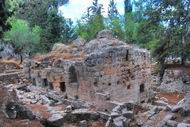
The Hasmonean period village was severely damaged following the 31BC earthquake that was centered in the Jordan valley. There were no casualties since the houses were vacant at that time.
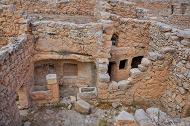
Biblical References:
The Bible has many descriptions of earthquakes, describing the fierce forces of the quakes and its affect on men.
Exodus 19:18: “And mount Sinai was altogether on a smoke, because the LORD descended upon it in fire: and the smoke thereof ascended as the smoke of a furnace, and the whole mount quaked greatly.”
Numbers 16:31-32: “|And the earth opened her mouth, and swallowed them up, and their houses, and all the men that appertained unto Korah, and all their goods. They, and all that appertained to them, went down alive into the pit, and the earth closed upon them: and they perished from among the congregation”.
1 Samuel 14:15: “And there was trembling in the host, in the field, and among all the people: the garrison, and the spoilers, they also trembled, and the earth quaked: so it was a very great trembling”.
1 Kings 19:11-12: “And he said, Go forth, and stand upon the mount before the LORD. And, behold, the LORD passed by, and a great and strong wind rent the mountains, and brake in pieces the rocks before the LORD; but the LORD was not in the wind: and after the wind an earthquake; but the LORD was not in the earthquake: And after the earthquake a fire; but the LORD was not in the fire: and after the fire a still small voice”.
Amos prophets on the coming earthquake of 759 BC (Amos1 1): “The words of Amos, who was among the herdmen of Tekoa, which he saw concerning Israel in the days of Uzziah king of Judah, and in the days of Jeroboam the son of Joash king of Israel, two years before the earthquake”.
Zechariah:14: “…and half of the mountain shall remove toward the north, and half of it toward the south. And ye shall flee … like as ye fled from before the earthquake in the days of Uzziah king of Judah: and the LORD my God shall come, and all the saints with thee”.
Amos 1:1: The prophet Amos witnessed the quake of 759BC. “The words of Amos, who was among the herdmen of Tekoa, which he saw concerning Israel in the days of Uzziah king of Judah, and in the days of Jeroboam the son of Joash king of Israel, two years before the earthquake”.
Micah 1:4: Micah also witnessed the quake of 759 BC (Micah 1:4): “And the mountains shall be molten under him, and the valleys shall be cleft, as wax before the fire, and as the waters that are poured down a steep place”.
Ant. XV:5: The major earthquake of 31 BC (magnitude 7) was one of the largest in 2,000 years. It destroyed cities in the Western Jordan valley (such as Masada, Qumran and Jericho), as reported by Josephus Flavius (Ant. XV, Chapter 5): “At this time it was that the fight happened at Actium [BW: 31 BC], between Octavius Caesar and Antony, in the seventh year of the reign of Herod and then it was also that there was an earthquake in Judea, such a one as had not happened at any other time, and which earthquake brought a great destruction upon the cattle in that country. About ten thousand men also perished by the fall of houses…”.
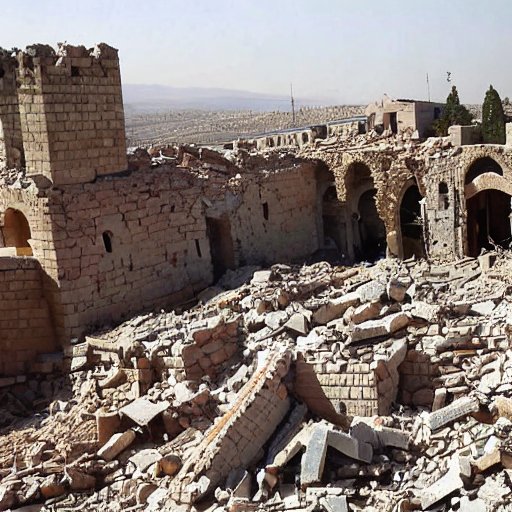
Earthquake destruction during ancient times – AI generated by Stable Diffusion
Matthew 27:51, 28:2: The quake of 33 AD, after Jesus was crucified (Matthew 27:51, 28:2): “And, behold, the veil of the temple was rent in twain from the top to the bottom; and the earth did quake, and the rocks rent”…”And, behold, there was a great earthquake: for the angel of the Lord descended from heaven, and came and rolled back the stone from the door, and sat upon it”.
Acts 16:26: An earthquake released Paul and Silas (Acts 16:26): “And suddenly there was a great earthquake, so that the foundations of the prison were shaken: and immediately all the doors were opened, and every one’s bands were loosed”.
Links and References:
Earthquakes:
- Greatest earthquakes of the Bible
- The Dead Sea Rift as a natural laboratory for earthquake behavior (pdf; 212 pages; 2009)
- Recurrence pattern of Holocene earthquakes along the Dead Sea transform revealed by varve-counting and radiocarbon dating of lacustrine sediments (pdf; Migowski, Agnon, et al; 2004) – recommended!
- Intraclast breccias in laminated sequences reviewed: Recorders of paleo-eathquakes (pdf; Agnon et el; 2006)
- Drilling down to the ice age at the Dead sea – summary of above
- Earthquake catalog for the Dead Sea Transform – open source by Jeff Williams (includes our photo and links)
- Crusader castle torn apart by earthquake at dawn (April 1998, pdf, 4 pages); Ronnie Ellenblum et. al.
- Megiddo IV 31 – Megiddo Earthquakes – Shmuel Marco, Amotz Agnon, Israel Finkelstein and David Ussishkin
- Quakes map
- Israel Seismic Activity Since The Times Of Jesus
- Latest quakes in Israel
- The earthquake of May 19, 363 – Kenneth Russell, 1980
- Damage patterns of earthquakes in Israel and its vicinity: Evaluation according to the historical sources – Motti Zohar (2016 GSI Thesis; pdf)
- Rock fall hazard evaluation down the Gilboa fault slope: Hefziba and Beit-Alfa” [Yuval Levy, Hebrew Univ. Thesis, 2014; 106 pages, Hebrew with English abstract] This study alerts on the danger of a 5+ magnitude earthquake to the people of the Kibbutz, due to falling rocks from Mt Gilboa.
- Archaeological destruction layers – a key to high accuracy Archaeo-magnetics, Arche seismic and chronostratigraphic Studies – Erez Hassul (pdf 125 pages; 2015)
BibleWalks.com – walk with us through the sites of the Holy Land
Roman Streets <<<—Previous—<<< All Info >>>—Next Info—>>>Columbarium
This page was last updated on Feb 26, 2025 (fix 1050 BC text)
Sponsored links:
.

